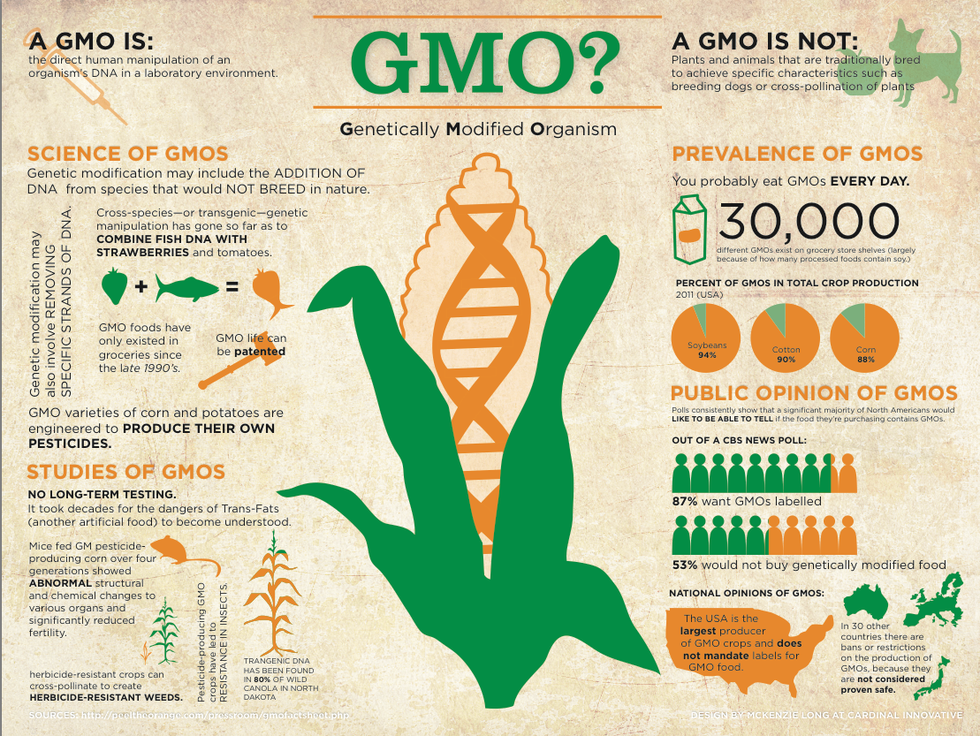Scientists scurry around the laboratory to find the gene resistant to most herbicides, including Roundup. Once a scientist finds the container, the others prepare for an experiment by gathering all the necessary equipment and tools to insert a new DNA gene sequence into the existing crop’s DNA. Another scientist on the team has created or mimicked the specific gene sequences they find valuable, like resistance to herbicides or pesticides. Very carefully, the first scientist inserts the new gene sequence into the experimental DNA through germ cells (sperm and egg cells) and let the rest of the reproduction process take over. Although this is a simplified depiction of the genetic engineering process, it is a crucial part in understanding the concept of GMOs.
In 1935, Russian scientist, Andrei Nikolaevitch Belozersky was able to isolate pure DNA, which eventually led to the production of the first edible GMO in the year 1994. According to University of California’s Agricultural department, tomatoes were the first GMO products on the grocery stores’ shelves. The tomatoes were called Flavr Savr tomatoes because their new gene sequence allowed a longer shelf life by delaying the ripening process. Over time, companies like Monsanto emerged and began focusing on GMO foods.
Companies creating genetically modified organisms have been receiving backlash from people for some time now. When the idea surfaced, it seemed like a great way to fight starvation in third world countries all over the world. Now, people are finding out that genetically modifying organisms come with a price. There are several organizations, like The Non-GMO Project, dedicated to showing how GMOs are bad for human consumption and what health threats are associated with them.
To better understand the risks people take when eating foods containing GMOs, imagine this scenario. A mother calls her son over for dinner as she cuts his steak into bite size pieces. She loads his plate up with a lump of mashed potatoes and corn on the side. Since a different brand of corn was on sale this week, the mother bought four ears of it for the family. Although this is the little boy’s favorite meal, after taking one bite, his mouth started itching and his airways slowly began to feel constrained as he gasped for air. Upon rushing to the hospital, the family found out their little boy had an allergic reaction to his food because his corn contained GMOs. The mother can’t help but think this situation could have been avoided had she known what she was buying.
This isn’t at all close to a natural process; in fact, GMOs created in laboratories encourage the possibilities of cross contamination in some sense. By altering a living organism’s DNA, new allergens are created and toxic chemicals become a threat to humans.
People have allergic reactions to the different proteins found in certain foods. When scientists begin to alter DNA, they start introducing different genes and proteins to the organism. These new proteins could cause allergic reactions for people that wouldn’t normally be allergic to the unaltered food. A common example is corn. Most of our corn supply contains GMOs, and some individuals may be allergic to a protein associated with the resistance to herbicides. When the new gene sequence is introduced to the corn, anyone that is allergic to that protein will have a reaction when they eat the corn. There has also been speculation that by introducing GMOs, people risk creating new allergens that we don’t fully understand yet.
One disease called eosinophilic esophagitis has become more prominent nowadays and part of that has to do with GMOs. People diagnosed with this illness experience swelling in their throat and extreme allergic reactions when consuming a food that contains specific proteins they are allergic to. When people change the DNA sequence in food, they risk adding different proteins that people would be allergic to. According to the Organic Consumers Association, the foods that are being genetically modified are also the most common food allergies, like soy, peanuts, eggs, shellfish, etc. The association also states on their website that these GMO foods are not subject to mandatory testing or labeling, which can create problems for most of the individuals prone to having food allergies.
Another issue involving the production of GMOs is the increased use of toxic chemicals, including pesticides and herbicides. It’s clear that scientists are using GMOs to create pesticide and herbicide resistant plants for consumption, but that leads to a bigger problem. With the increase in this resistance, farmers are spraying their plants more with weed and insect killers like Roundup. Now, not only are people consuming genetically modified foods with the risk of containing allergens, but they’re also consuming plants sprayed with more than the recommended amount of pesticides and herbicides.
On Monsanto's website, they claim GMOs could help the economy and nations across the world by allowing people to use fewer fuels and pesticide sprays. In reality, farmers must use more chemicals because of the unnatural resistance of super weeds and super bugs.
When talking about GMOs, it’s only fair to say these organisms weren’t created to cause health problems in the general population. The idea of GMOs seemed promising because there would be a higher crop yield each year and it could help put food on more plates as time went on. Companies like Monsanto hoped to help third world countries and prevent starvation across the world.
Many countries have already banned the use of GMOs or have constructed higher regulations to protect their people. If other nations see a problem in the creation of GMOs, then it doesn’t make sense to continue with this charade. Although GMO companies are looking to make a difference in the agriculture world and help people in starving countries, this may not be the best solution for famine. It’s an uneasy thought that scientists are mutating the food supply without the peoples’ consent.
Currently, GMOs companies are not required to label their products as such. In return, people aren’t aware of what they are getting in their foods. Organizations like The Non-GMO Project have made it their job to exploit GMO companies and the risks people take every day when they take a bite into an apple. For some, an apple a day won’t keep the doctor away; instead, it could land them in a hospital for an allergic reaction involving GMOs.
The least this government can do is require companies like Monsanto to label their products that contain GMOs. In the end, it will be up to the individual person whether or not they would like to ingest corn, soybeans, sugar beets, potatoes, and other fruits and vegetables containing genetically modified organisms.
Despite the desire for GMO labeling from the people, these companies are refusing to do so and that is saying something about the quality of food that they are producing. If GMOs were healthy for humans, then companies like Monsanto shouldn’t have a problem with labeling their products as such. It seems like these companies are worried about losing money and customers if they are required to label genetically modified foods. So instead of having enough knowledge for people to form their own opinions regarding the use of GMOs, they are forced to ingest foods without realizing what they could potentially be putting into their bodies.
Instead of imaging groups of mad scientists genetically modifying food across the nation, why not give society all the necessary information in order to make a logical decision regarding GMO foods? Frankly, many people would choose not to put harmful chemicals found in pesticides like Roundup in their bodies, so it doesn’t make sense to eat foods with genetically modified organisms. In the end, companies like Monsanto are actually hurting their own business because people won’t stop until these foods are at least labeled in stores.





















